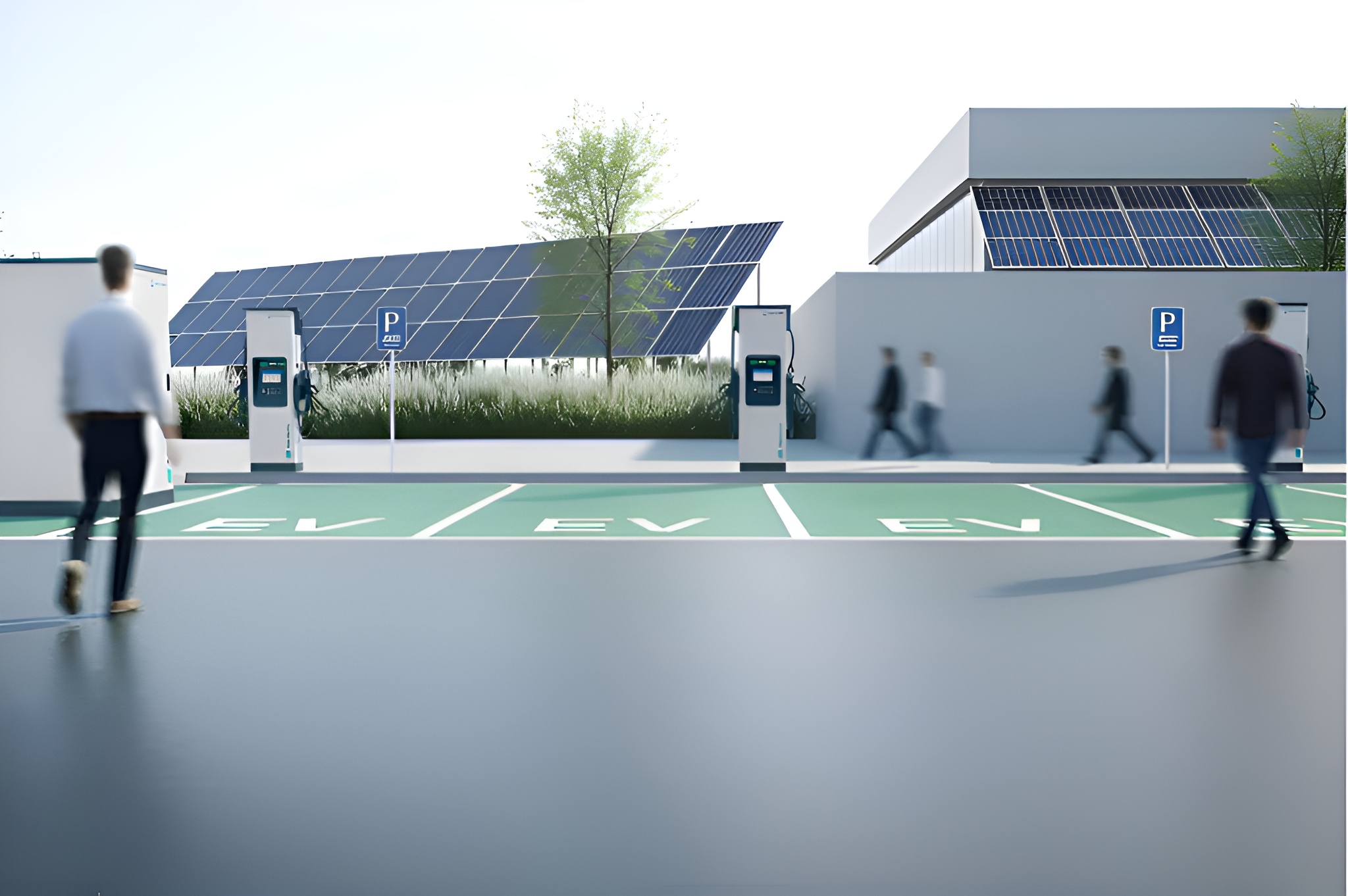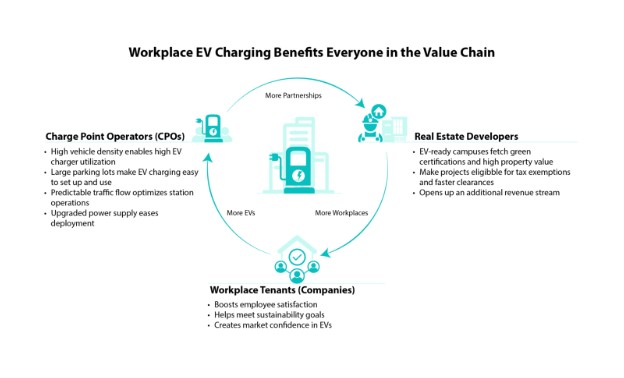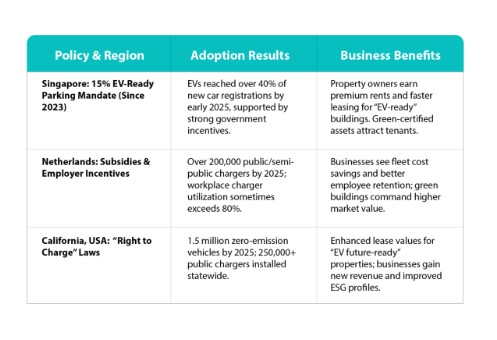Workplace EV charging in India: The role of Industrial Parks, SEZs, and offices

Welcome to the first episode of our blog series on ‘different shapes and forms of electric vehicle (EV) charging’. In this series, we talk about the most practical way of establishing EV charging stations – invest where it makes sense.
Today’s blog is going to be about EV charging in workplaces: the why, and the how.
India’s industrial parks and SEZs host a very high number of vehicles.
India has over 270 active Special Economic Zones (SEZs) and more than 3,500 industrial parks. It is estimated that around 18 to 22 million vehicles enter these workplaces on a daily basis. These vehicles are one of the main sources of carbon emissions in the country, especially in cities.
This is critical, given that the number of vehicles on Indian roads is growing at a fast pace. The government is actively pushing for electrification of such vehicles to curb emissions and meet net zero goals.
The official target?
30% new vehicles in India must be electric vehicles (EVs) by 2030. Extensive measures are being taken across the country to ensure that these EVs have adequate charging infrastructure.
Now, here’s the catch.
A significant number of private vehicle owners (including EV owners) in India, are corporate professionals working in offices. Fleet vehicles also operate out of urban centers like Industrial Parks and SEZs.
Though EV charging infrastructure in India has exponentially expanded to over 25000 public EV charging stations, less than 10000 EV charging stations serve the space where most EV owners spend their time – workplaces.
This presents a huge business opportunity for developers and CPOs.
As India fast-tracks its electric mobility ambitions, having robust EV charging infrastructure in industrial hubs is critical for:
- Business competitiveness
- Decarbonization
- User convenience
- Future-readiness
Workplace EV charging benefits everyone in the value chain.
Why?
EV charging in workplaces promises 3 crucial things: Convenience, Cost-saving and Competitive-edge.
To whom?
Key stakeholders in workplace EV charging:
- Charge Point Operators (CPOs)
- Real-estate players
- Workplace tenants (companies)
A. It eases operations and boosts profitability for CPOs
High vehicle density, expansive parking facilities, predictable traffic patterns, and reliable power supply collectively drive efficient utilization and operational excellence for CPOs.
1. High vehicle density enables high EV charger utilization.
Massive campuses like Infosys Mysore or Reliance SEZ in Navi Mumbai witness thousands of vehicles daily. Workplace EV charging stations enable high utilization ratios, thus high revenues for CPOs.
2. Large parking lots make EV charging easy to set up and use.
Industrial parks and SEZ campuses typically feature large, well-organized parking areas for employees, visitors, and fleet vehicles. This existing infrastructure makes it straightforward to install EV charging stations without investing in land. Ample parking space also allows for multiple dedicated charging bays.
3. Predictable traffic flow optimizes station operations
Industrial parks serve as transport hubs for e-commerce, warehousing, and goods movement. They are frequented by both heavy and light-duty fleet vehicles. This happens on a fixed schedule round-the-clock. The presence of reliable and scalable EV charging infrastructure benefits logistic companies, as vehicles can charge at loading or idle time. Due to the number of vehicles and their timings being fixed, it is must easier for a CPO to forecast power demand and optimize operations of the EV charging station here, than on a random road with random traffic flow.
4. Upgraded power supply ease deployment
Upgraded power supply at workplaces simplifies EV charger deployment by ensuring stable, high-capacity electrical infrastructure. It reduces the need for major electrical upgrades, shortens installation time, and supports multiple chargers efficiently.
B. It creates additional income and regulatory ease for real-estate players.
Integrating EV-ready infrastructure helps secure green building certifications, tax incentives and expedited approvals. It also opens up diversified revenue streams through partnerships and premium services.
1. EV-ready campuses fetch green certifications and high property value
Green building certifications (IGBC, GRIHA) increasingly reward “EV ready” campuses that are equipped with pre-laid charging infrastructure and smart metering systems. Now that EVs are increasingly becoming the norm, and sustainability goals for companies have become even more important, tenants have started looking for these amenities upfront. EV charging readiness enhances property value and sustainability branding.
2. Make projects eligible for tax exemptions and faster clearances
Real-estate developments that integrate EV-ready campuses become eligibile for various fiscal incentives: like property tax rebates, concessional stamp duties, and capital expenditure subsidies. Such regulatory relaxations shorten project timelines and reduce upfront costs, making EV readiness not just environmentally responsible but financially prudent.
Examples: Maharashtra’s EV policy offers expedited building approvals and reduced property taxes for new industrial parks that commit to minimum EV charging station coverage. Tamil Nadu and Karnataka provide faster environmental and utility clearances for projects demonstrating sustainability through EV infrastructure.
3. Opens up an additional revenue stream
Increasing EV penetration is making CPOs explore partnerships in business models. A share of revenue from EV charging goes as rent/profit share to the space owners. Beyond direct charging fees, EV infrastructure also drives ancillary revenue opportunities. Advertising space for other brands, partnerships with food chains, exclusive charging contracts with fleet operators and many such profitable avenues can open for real-estate developers.
Between 2023 and 2024, Embassy Tech Parks installed around 100 chargers across six parks—including private and shared bays, e-rickshaw docks, and dynamic peak pricing—using a mix of 7 kW AC and 25 kW DC chargers with load balancing. The initiative led to an improved green building ratings, and higher tenant satisfaction
C. It boosts employee satisfaction and sustainability score for companies.
Convenient workplace EV charging significantly improves employee satisfaction and retention. It also advancing corporate sustainability goals and strengthens the company’s ESG performance.
1. Creates employee convenience
Workplace EV charging stations eliminate the hassle of finding public chargers and taking a detour. An employee can easily start charging their EV when they come in, and they’ll get a fully charged car till its time for them to leave.. No need for waiting in line.
This removes daily friction—one of the biggest barriers to EV adoption in urban India Helps meet sustainability goals
Corporations showcasing robust EV charging infrastructure enhance their ESG credentials, gaining favor with global clients and investors focused on sustainability.
2. Helps in building market confidence for EV Ecosystem
Convenient workplace charging improves daily ease for employees and accelerates EV adoption by boosting market confidence. At DLF IT SEZ Chennai, the installation of a dedicated EV charging bay led to a 30% rise in employee EV adoption within five months—proving that visible, accessible infrastructure makes EVs a more compelling choice.
3. Helps in meeting sustainability goals
Integrating EV charging infrastructure in office space boost the ESG credentials of companies. These helps them gain competitive advantage, when it comes to clients and investors in the global market.

While we’re looking at the benefits, EV charging stations can’t really flourish without governmental support, can they? Let’s look at key policies that are important in this context.
Policy Support for Workplace Charging Is Taking Shape
Central and state governments have created supportive policies for workplace EV charging. These measures streamline approvals, reduce costs, and encourage faster adoption of EV infrastructure in commercial and industrial settings.
1. EV charging has been made a de-licensed activity
According to the 2024 guidelines by the Ministry of Power, any entity can establish EV charging infrastructure. Setting up and operating EV charging stations doesn’t require any separate license or permits, unlike petrol pumps.
2. Tax reductions have been boosting EV charging infrastructure integration.
GST on services in EV charging stations has been reduced to 5%, and projects with EV charging infrastructure benefit from streamlined clearances.
3. EV charging stations in industry hubs have been a key focus of the central PM E-Drive scheme
PM E-DRIVE, which allocated INR 2000 crore for expanding public EV charging infrastructure has put special emphasis on installing EV charging stations in/near fleet depots.
4. EV charging infrastructure in new commercial projects have been mandated by State Regulations
Maharashtra, Tamil Nadu, Karnataka, and Delhi mandate EV charging infrastructure in new industrial parks and commercial buildings. Noida and Gujarat require 5–10% of parking spots to have EV charging stations for certified green buildings.
A step in the right direction, given results from global precedents

Amazon’s Approach Demonstrates Practical EV Integration Success
Amazon India has shown how large-scale investment in EV charging infrastructure can transform business and environment metrics. The e-commerce giant targets net-zero carbon by 2040 as a part of its Climate Pledge. For that, it committed to electrify its last-mile delivery fleet. Amazon deployed over 100 EV charging stations in 30+ distribution centers across India.
Many of these EV charging stations featured rooftop or carport solar installations, reducing carbon footprints and operational costs per kWh. To ensure charger availability and uptime, Amazon created SLA based partnerships with top CPOs like Pulse Energy and EVRE.
Amazon’s model is now a benchmark, inspiring the logistics sector’s rapid shift towards workplace and depot EV charging infrastructure.
While the opportunity is clear, setting up EV charging at workplaces still raises a key question: how do we make it viable, especially with upfront investments involved? The answer lies in building smarter, scalable, and more convenient solutions.
5 ways in which workplace charging can be made smarter, scalable and convenient
1. Invest in EV Chargers that have DLM, multi stack charging and dual gun mechanisms.
Industrial parks, SEZs and offices see multiple vehicles of multiple types on a daily basis. A lot of them often appear together for charging but have different charging needs. In these cases,
- A dynamic load manager (DLM) can intelligently balance power demands between multiple vehicles.
- Multistack charging can cater to different charging profiles at the same time. There is no need to segregate vehicles on the basis of which EV charger is prioritizing which profile.
- Dual guns have the obvious advantage of serving two vehicles at one, which means half the total number of EV chargers are required.
2. Invest in Smart EV chargers that can optimize load and do predictive maintenance.
Smart charging protocols can balance load demand, forecast charging needs to minimize waiting times. AI-powered algorithms monitor EV charger component data to detect anomalies and predict failures before they happen.
3. Invest in EV charging architecture that enables remote monitoring
IoT-enabled EV charging infrastructure allows operators to monitor all necessary metrics remotely. This includes details like energy consumption, utilization rates, demand curves, and fault probabilities.
4. Invest in energy storage and renewable Integration
Integration with rooftop solar panels can reduce grid dependence and make your EV charging station even more eco-friendly. Using a battery-boosted EV charger here can give you two extra advantages:
- Use and store excess solar energy during the daytime, which costs less than half of grid electricity, directly reducing monthly bills
- Provides a power backup in case of grid failure
5. Invest in user experience
Small, but significant features – like unified booking and payment platforms, multilingual UI/UX, mechanically assisted cable handling enhance user convenience. This is critical for multi-tenant office campuses and industrial parks with fleet operators, as these places see drivers of diverse needs.
EV Charging in workplaces holds the key to ecosystem growth
India’s SEZs, workplaces, and industrial parks hold the key to rapid EV adoption. In these spaces, EV charging stations should be treated as core business infrastructure, not a mere add-on.
Explore our future–ready EV chargers here.
FAQs:
Q: Why are industrial parks and SEZs critical for EV charging infrastructure in India?
A: Industrial parks and SEZs host large numbers of employees and commercial vehicles daily, creating a concentrated and predictable demand for EV charging. They often have ample parking, upgraded power supply, and space to install scalable charging infrastructure, making them ideal EV charging hubs.
Q: How do EV charging stations benefit real-estate developers?
A: Developers gain increased property value, green certifications, eligibility for tax incentives, faster project approvals, and additional revenue streams through partnerships and ancillary services linked to EV chargers. This enhances tenant satisfaction and future-proofs assets.
Q: What government policies support workplace EV charging in India?
A: Central schemes like PM E-DRIVE allocate funding for charging infrastructure with emphasis on fleet depots. State policies in Maharashtra, Tamil Nadu, Karnataka, and Delhi mandate EV charging in new commercial projects and offer tax breaks and expedited clearances. Additionally, EV charging is de-licensed, simplifying establishment.
Q: What utilization rates are observed at workplace charging stations in Indian SEZs?
A: Industry reports suggest peak-hour utilization rates of 60-80%, driven by high vehicle density and predictable operating hours, resulting in steady revenue for charging station operators.
Q: How does workplace EV charging help companies meet sustainability goals?
A: By providing accessible EV charging, companies reduce their fleet emissions, improve employee EV adoption, and boost their ESG ratings, aligning with global sustainability demands and investor expectations.
Bibliography
- Ministry of Power, Government of India. (2024). Guidelines on De-Licensing EV Charging Infrastructure. New Delhi: Government of India.
- Ministry of Heavy Industry, Government of India. (2024-25). PM E-DRIVE Scheme Overview: Promoting Electric Mobility and Charging Infrastructure Expansion. New Delhi: Government of India.
- State Governments of Maharashtra, Tamil Nadu, Karnataka, and Delhi. (2023-2024). State EV Policies and Mandates for Workplace Charging Infrastructure. Various official state gazettes and policy documents.
- Central Electricity Authority (CEA), India. (2025). Electricity Consumption Data at Public EV Charging Stations: April 2024 – February 2025. New Delhi: CEA.
- CareEdge Ratings. (2025). Indian Public EV Infrastructure and Usage Trends Report. Mumbai: CareEdge Ratings.
- Vasudha Foundation. (2025). Electric Vehicle Adoption and Charging Infrastructure Development in India. Mumbai: Vasudha Foundation.
- Powerline Magazine. (2025). Insights on the Indian EV Charging Market: Opportunities and Challenges. New Delhi: Powerline Publications.
- S&P Global Mobility. (2024). Indian Electric Vehicle Market Analysis. New York: S&P Global.
- Indian Green Building Council (IGBC). (2024). Green Building Certification Guidelines: EV-Ready Infrastructure. Hyderabad: IGBC.
- GRIHA Council. (2024). Sustainable Building Rating Systems Including EV Charging Readiness. New Delhi: GRIHA.
- Singapore Ministry of Transport. (2023). EV-Ready Parking Mandate for Non-Residential Buildings. Singapore Government Publication.
- Netherlands Enterprise Agency (RVO). (2024). Subsidies and Incentives for Workplace EV Charging Infrastructure. The Hague: RVO.
- California Air Resources Board (CARB). (2024-25). “Right to Charge” Laws and EV Adoption Data. Sacramento, CA: CARB.
- Industry Reports & Case Studies (2023-25). EV Charging Infrastructure Deployment in Indian SEZs and Industrial Parks.
- Amazon India. (2023-25). Sustainable Mobility and EV Charging Infrastructure Initiatives. Internal company reports and public announcements.
Frequently Asked Questions
Lorem ipsum dolor sit amet, consectetur adipiscing elit, sed do eiusmod tempor incididunt ut labore et dolore magna aliqua. Ut enim ad minim veniam, quis nostrud exercitation ullamco laboris nisi ut aliquip ex ea commodo consequat. Duis aute irure dolor in reprehenderit in voluptate velit esse.
Lorem ipsum dolor sit amet, consectetur adipiscing elit, sed do eiusmod tempor incididunt ut labore et dolore magna aliqua. Ut enim ad minim veniam, quis nostrud exercitation ullamco laboris nisi ut aliquip ex ea commodo consequat. Duis aute irure dolor in reprehenderit in voluptate velit esse.
Lorem ipsum dolor sit amet, consectetur adipiscing elit, sed do eiusmod tempor incididunt ut labore et dolore magna aliqua. Ut enim ad minim veniam, quis nostrud exercitation ullamco laboris nisi ut aliquip ex ea commodo consequat. Duis aute irure dolor in reprehenderit in voluptate velit esse.
Lorem ipsum dolor sit amet, consectetur adipiscing elit, sed do eiusmod tempor incididunt ut labore et dolore magna aliqua. Ut enim ad minim veniam, quis nostrud exercitation ullamco laboris nisi ut aliquip ex ea commodo consequat. Duis aute irure dolor in reprehenderit in voluptate velit esse.
Lorem ipsum dolor sit amet, consectetur adipiscing elit, sed do eiusmod tempor incididunt ut labore et dolore magna aliqua. Ut enim ad minim veniam, quis nostrud exercitation ullamco laboris nisi ut aliquip ex ea commodo consequat. Duis aute irure dolor in reprehenderit in voluptate velit esse.




